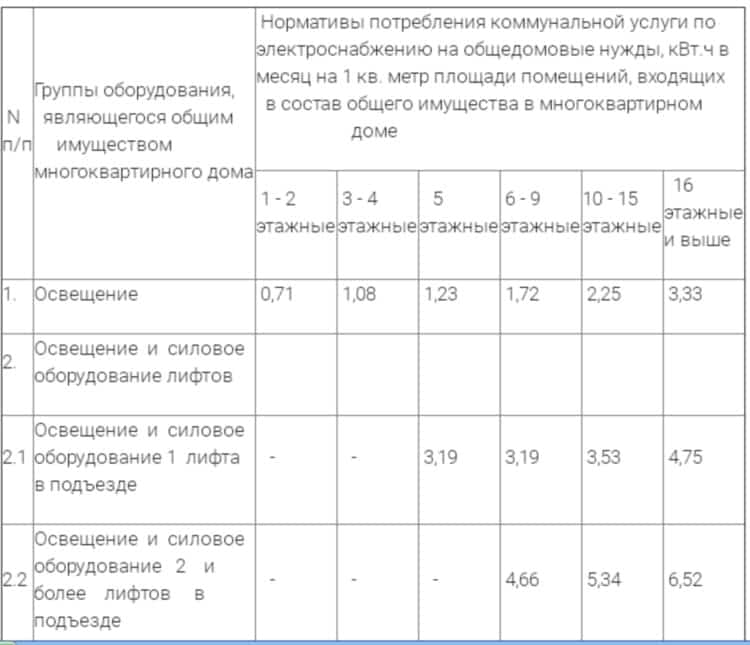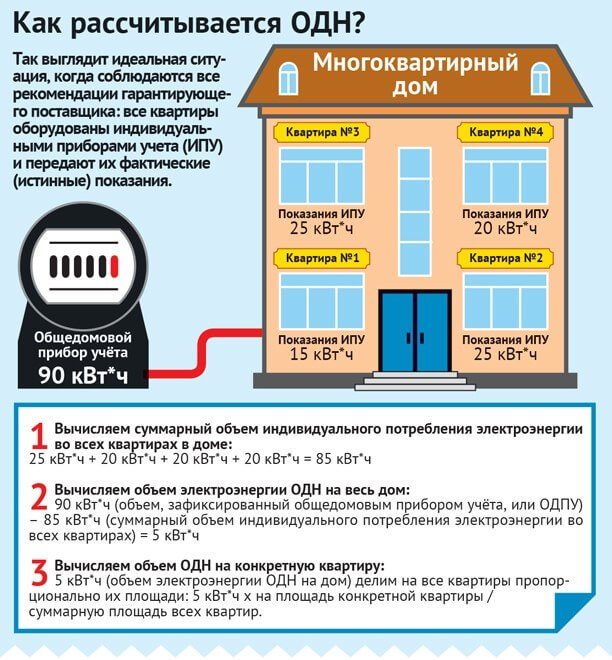Legal advice > Administrative law > Utilities > Is it necessary to pay ODN for electricity, basic calculations
All residents of apartment buildings know that they must pay utility bills every month. If you don't do this, the debt will grow, and then you will have to deal with it in court and, in the end, still pay, unless the citizen goes bankrupt.
Recently, such a separate item as general household needs has appeared in receipts. What are they and do you need to pay one for electricity? Let's talk about this in detail.
What does ODN apply to?
General household needs on receipts are indicated briefly as “ONE”. According to Art. 36 of the Housing Code of the Russian Federation, the property of common household use of an apartment building (or apartment building) means premises that are not related to residential premises and are used for the use of all those who live in the house.
It turns out that ODN refers to utility payments collected for the maintenance of property for common household use. In other words, the calculation is made in relation to those territories where metering devices for apartment owners cannot be installed individually.
For example, if an apartment building is connected to central heating, then the owners pay for heat based on the area of the occupied premises. However, there are also batteries on the stairs, thanks to which a certain temperature is maintained. So, the cost of heating in the entrance will be included in the ODN. This will also include technical losses in utilities and equipment.
So, common areas include the following:
- Entrances.
- Elevators and shafts.
- Attics and technical floors.
- Basements.
- Premises with engineering systems.
- Others that are not the property of any specific residents.
- The adjacent territory, as well as elements of its improvement.
To keep all these rooms in good condition, water, coolants, gas and, of course, electrical energy are consumed.
In relation to electricity, which is discussed in the article, ODN includes such expenses as:
- Elevator operation.
- Operation of intercoms.
- CCTV.
- Supply of light in the entrance and nearby the house.
- Maintenance of alarms (fire and other).
Standard for electricity and general household needs

Each region of the Russian Federation sets its own indicators. Below are the indicators that apply in some regions: In Moscow and the Moscow region. In high-rise buildings without elevators and electrical installations for heating and water heating, the standard is 0.61 kW/h, with elevators but without appropriate installations - 2.88 kW/h, without elevators, but with electrical devices for heating and water heating, regardless of season - 0.61 kW/h.
In St. Petersburg and Leningrad region. In apartment buildings without elevators and installations for heating and water heating - 0.43 aKW/h, with pumps - 0.94 kW/h, with elevators, but without installations - 1.66 kW/h, without elevators, but with installations in heating period - 4.87 kW/h, and outside the heating period - 1.36 kW/h.
In the Rostov region. If only light bulbs are installed in a high-rise building, then the payment will be 0.6 kW/h. But with an elevator, the costs will be 1.7 kW/h, and with pumps – 0.9 kW/h.
In the Novosibirsk region. For three-story apartment buildings for 1 sq. m of electrical energy will have to pay 0.907 kW/h, for five-story apartment buildings - 2.210 kW/h, for twelve-story apartment buildings - 4.411 kW/h, for thirteen-story apartment buildings - from 6.128 to 7.014 kW/h, depending on whether an individual heating point is installed there or not .
In the Saratov region. Residents of two-story houses pay 0.59 kW/h for light in the entrance, of four-story houses - 0.84 kW/h, and if there is a pump, then the standard will be 0.97 kW/h, in nine-story houses it will be 1.82 kW/h, but with an elevator - 2.4 kW/h, with a pump - 2.10 kW/h, with power units - 2.72 kW/h.
How is the ODN standard for electricity calculated and what is its size in 2020?
- lighting of staircases, vestibules, entrances;
- electricity necessary for uninterrupted operation of intercoms;
- electricity consumed by elevator cabins;
- electricity for video cameras, if they are installed in the house;
- technological losses recorded in intra-house networks.
Interesting read: How many families in the Saratov region received subsidies per year under the young family program
General house electricity needs are part of the resource that is spent on maintaining and providing lighting to a high-rise building, outside the share of electricity that the owner uses within his residential property. That is, the cost of electricity includes the following list of costs:
How to calculate correctly and calculation procedure
For the calculation you will need the following values:
- Readings from a common household meter.
- Electricity spent in all premises of non-residential apartment buildings.
- Electricity consumed in residential premises where there are no individual metering devices.
- Electricity consumed in residential premises where there are individual devices.
- The area of a separate dwelling.
- The area of all apartments in total.

Experts are confident that the final amount that the user will have to pay largely depends on whether a common building meter is installed in the apartment building or not. In its absence, the calculation is carried out according to old standards, which are significantly higher than the current ones.
Electricity ONE according to metering device
If the residents have taken care to install a common house meter, then the ODN is read by Energonadzor employees together with a representative of the residents, who is selected for this at the general meeting (at the residents’ request, the calculation is carried out by Energonadzor employees without their participation). The calculation is based on the difference between the indicators of the general metering device and the values of all devices installed in individual apartments.
The amount is divided between apartment owners, but not equally, but depending on the occupied space. The larger the property, the more its owner will have to pay for general household needs. The formula for calculating electricity looks like this:
E/e according to ODN = (Value for a common house metering device – E/e value for the maintenance of common household property – Value of meters for all apartments – E/e value calculated according to standards in those apartments where there are no metering devices) * (Area occupied apartments/Area of all apartments in a high-rise building).
If there is no common household metering device, the calculation of electricity for the ODN is based on the value that is valid in a particular region. As a rule, the standard is significantly higher than the actual usage value, which is shown by the general house meter.
If the calculation shows a negative result
This option may occur when the volume according to the common house meter is less than the volume consisting of readings from individual meters.
A situation may arise when some apartments do not have individual metering devices; they pay for electricity according to current standards, while in fact they consume significantly less energy.
The contractor must recalculate the difference, which is divided between the apartment owners. Therefore, if the payer finds a negative value in the receipt for general household needs, then the utility company may have made a recalculation.
For example, the difference between the values of a common household meter and the sum of individual indicators is 130 kW/h. 150 residents are registered in the apartment building. The difference will be calculated as follows: -130/150=-0.87. If two people are registered in an apartment and they consumed 100 kW/h in one month, then the consumed electricity will be reduced by 2.61 kW/h.
How to calculate one tax for electricity: formula
To make it comfortable for residents to live in multi-storey buildings, the authorities use a resource that allows them to maintain and ensure constant and uninterrupted lighting of high-rise buildings (the share that residents use to support their own needs is not taken into account). Residents are required to pay ODN, and fees may vary. To calculate energy consumption, a standard is used.
Every year the standards can be revised: they can either decrease or increase.
To save on paying for single use, each tenant can install a meter. Anyone who does not want to overpay and pay for extra kilowatts should be able to correctly calculate ODN. If a multi-storey building is equipped with a device that takes into account electricity consumption, the needs for the house are determined by Energy Supervision and representatives of the house.
Formula for determining ODN:
- The value recorded on the electricity meter;
- The total electricity that went into lighting non-residential square meters;
- The total amount of resources for all residential apartments with built-in meters;
- The amount of electricity used in apartments without meters.
If the house does not have a device that takes into account the electricity consumed, the standard set by the regional administration is taken per unit of payment. The size of the payment unit for each individual region can be found on its official website. The standard is a limit value that residents can increase at their own discretion.
E/e ODN for non-residential stock
It’s not only apartment owners who have to pay ODN. This obligation also applies to owners of non-residential premises. Therefore, apartment owners should not worry about the cost of electricity, for example, for a hairdresser located on the ground floor of an apartment building, since the payment for electricity supply is carried out equally from both apartment owners and those who own non-residential premises. The main parameter on which calculations are based is the area of the occupied premises, and not the status.
Payment for general house needs (GDN) from January 1, 2020, transfer to housing department
In addition, experts included in the standard the volumes of water that will be needed for cleaning the front doors and scheduled (twice a year) flushing of the heating system. All this, according to experts, will allow residents of apartment buildings to pay for water used for general house needs, exactly as much as is necessary directly for servicing the house.
Comfortable living in an apartment building requires heating and lighting not only in the apartments themselves, but also in common areas, front doors and numerous technical rooms. Today, management companies use the practice of allocating the costs of maintaining such areas to general house needs (GDN). They are paid by apartment owners, and the corresponding payment amounts are indicated in receipts for utility bills. In 2020, federal officials made changes to the payment of ODN and proposed to classify them as expenses falling under the category of payments for the maintenance of residential premises. When will the transfer of the payment for one-day rent to the housing service take place? How will this affect the payment amount? What will the ODN fee be in 2020? And what can help residents of apartment buildings save on one-room apartments?
Do I need to pay ODN for electricity?
You need to understand and know the ODN standards in force in your region of residence. If the indicator exceeds the norm, then residents have the right not to pay for general household needs. The exception is the case when the residents themselves voted to, if necessary, pay ODN in excess of the norm.
There are also situations in which the management company goes bankrupt. At the same time, RSO, not being able to recover the appropriate funds from the bankrupt company, issues an invoice for ODN directly to the residents. You need to know that such actions are illegal, and residents have the right not to pay such a bill.
If a common house meter is installed
If there is a common household meter, employees of the management company take readings from it monthly.
The devices show the amount of electricity, as well as heat, gas and water consumed from the entire building, and from each apartment separately. After collecting readings from apartment metering devices, a calculation is made for an individual apartment and the amount of consumption by all residents of the house is displayed. Both values are compared, the remaining difference becomes the expense for general household needs.
To obtain correct data, all values must be taken in the same period. The amount is distributed among users of the premises taking into account the occupied space.
Legal regulation
Federal Law of the Russian Federation N176 “On Amendments to the Housing Code of the Russian Federation and Certain Legislative Acts of the Russian Federation” dated June 29, 2020 is the main legal act that regulated the payment of communal electricity. On April 3, 2020, further changes were made to it.
Important! The purpose of this regulatory legal act was:
- creation of favorable operating conditions for housing and communal services;
- reducing the number of defaulters;
- ensuring a balance between the amount paid and the service consumed.
Thus, after the adoption of the amendments, management companies are required to equip each house with a common house meter and charge only for the electricity actually consumed.
The legislative framework regarding the payment of payment for general house services consists of several documents:
- Federal Law N261 “On energy saving and increasing energy efficiency and on introducing amendments to certain legislative acts of the Russian Federation” dated November 23, 2009;
- Decree of the Government of the Russian Federation N354 “On the provision of utility services to owners and users of premises in apartment buildings and residential buildings” dated May 6, 2011;
- Decree of the Government of the Russian Federation N344 “On amendments to certain acts of the Government of the Russian Federation on the provision of utility services” dated April 16, 2013;
- Federal Law N176 “On Amendments to the Housing Code of the Russian Federation and certain legislative acts of the Russian Federation” dated June 29, 2020.







